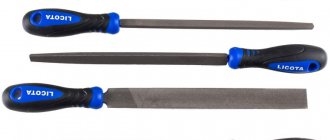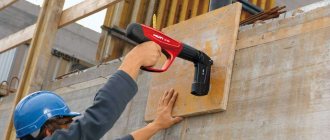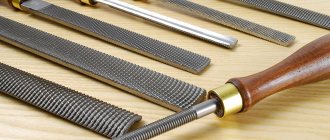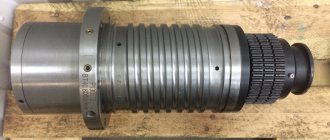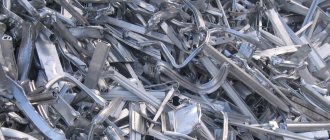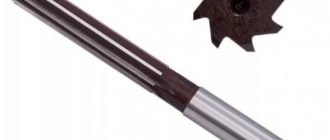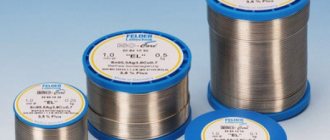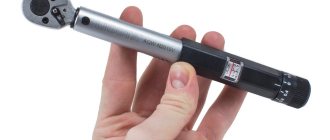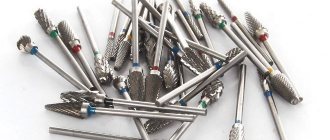After a drilling operation, very often there is a need to improve the quality of processing of the resulting hole. Depending on whether the hole was made through or only part of the part was drilled, so-called countersinking or countersinking is used. The translation from German of these names “to pass”, “to deepen” quite accurately reflects the operation being performed. Countersinking is used for mechanical processing of prepared holes. During this operation, additional boring of holes is carried out using special tools such as a countersink or a countersink in order to improve the quality of the resulting surface.
Countersink for metal
Externally, this tool resembles an ordinary drill. That’s why you can sometimes come across the term countersink drill. Features of countersinks for metal include the presence of a larger number of cutting surfaces. They are made in the form of spiral linings, cutting edges or cutting teeth.
Types of countersinks
Countersinks according to their geometric shape are divided into: cylindrical, conical, end-face. Depending on what result should be obtained, the appropriate type of tool is used:
- • for working with cylindrical parts and shapes. They have different diameters and angles of inclination. Designed to expand the hole up to 10 mm. Using a guide pin, recesses for fasteners are made;
- • for working with conical parts (sensors, valves). The surfaces being processed are usually made of cast iron and steel;
- • for processing the end plane of a part or product (booms, bosses).
Countersinks are classified according to the type of construction: solid, prefabricated, welded and with overlay carbide plates. According to the method of fastening: tail and mounted countersinks.
Terminology
A countersink is a multi-bladed cutting tool used for making holes in metal parts. After processing, conical/cylindrical type recesses are obtained, you can create a reference plane near the holes, and chamfer the center hole.
Countersinking of holes is the secondary preparation of finished holes for placing hardware heads - bolts, screws, rivets
A countersink is a cutting tool with a multi-bladed surface. Used in machining cylindrical/conical holes in workpieces to expand the diameter, improve surface characteristics and accuracy. This type of processing is called countersinking. This is a semi-finish cutting process.
Countering holes is the process of reworking the top of an opening in order, for example, to remove burrs from the edge of a hole or to create recesses to hide the head of a rivet or screw and level it with the surface of the part. The tool used for this task is called a countersink.
Countersinking
The work is performed on lathes (to produce holes from the end side), drilling, CNC milling and boring machines (to change the size of the hole). The selection of tools is made based on the location of the hole and material, the depth and size of the hole, and the method of fastening. The processing speed in countersinking is identical to the drilling speed. For light steel, the angle of inclination is 15-20 degrees, for medium-light alloys - 8-10 degrees. High-alloy steels and cast iron are processed at an angle of 0-5 degrees, according to GOST 12479-71.
The use of automatic equipment allows us to achieve high precision of the processed surface. When performing work, you must adhere to the following safety rules: the surface of the countersink must be well sharpened and free of burrs and cracks. When attaching the shank, you need to pay attention to the smoothness of the surface as fasteners.
This processing is similar to a drilling operation. Only in the case of countersinking does the final version come out more accurate, the surface cleanliness improves in the process, and any errors are eliminated. Next, reaming is usually performed - a type of finishing.
Countersinking is the secondary processing of ready-made holes for installing bolt heads, rivets, and screws into them.
What are these instruments like nowadays?
Countersinks of all types are made of high-alloy steel materials, as well as alloys with different cutting angles. Countersinks are divided into different types. Does this determine which specific type to use?
These instruments differ primarily in their design. Their differences depend on the conditions of use on CNC equipment and machine tools, as well as on GOST. According to their design, countersinks are divided into the following types.
— Attachment countersink. It belongs to the high-speed type of parts. It is made from high-alloy alloys. Indicated by the marking P6M5. Can be of different diameters. From 25 to 75 mm.
- Carbide. This is also a mounted countersink of various diameters. Its design contains plates made of hard alloy. It is marked VK8. There is one particular thing here - for example, the marking VK8 25 means that the countersink has hard alloy plates with a diameter of 25 millimeters. And if the marking is VK28 75, then this means that the diameter of the plate is 75 millimeters. Typically, this alloy is used when working with molds made of steel or cast iron with a high content of alloying elements.
— The same marking, BK8, is used to mark the tail mounted countersinks. This is a part that is equipped with a special conical shank.
- Whole. The most affordable, but at the same time type of countersink with the lowest productivity. Usually, if you need more precise processing and greater speed, other prefabricated options labeled BK8 are used.
How does a countersink differ from a countersink?
Often a countersink is confused with a countersink. Countersink and countersink - belong to the class of cutting tools, with 3 or more cutting edges. Both tools are used for conical and cylindrical holes. But the countersink expands the hole, at the same time grinding it and adjusting it to the specified parameters. And the countersink only polishes the hole from burrs at the finishing stage.
Current GOSTs
A countersink is a high-precision tool. All its geometric dimensions, the angles of the cutting edge in the conical element, the shape of the blade spiral, and the number of blades are strictly specified by standardization standards in GOST. Thus, the current documents on different types of countersinks are as follows:
- GOST 14953-80 describes the conditions (technical) for using elements with a conical working area. The geometric parameters, the material from which the tool is made, and the metal with which a particular element can work are indicated.
- GOST 12489-71 concerns such a tool as a one-piece cylindrical countersink.
Dear site visitors, who have information related to the topic, support the discussion in the comments!
TECHNICAL REQUIREMENTS
2.1. (Deleted, Amendment No. 2). 2.2. Countersinks must be made from high-speed steel in accordance with GOST 19265. It is allowed to manufacture countersinks from other grades of high-speed steel, ensuring the performance and durability of countersinks are not inferior to countersinks made from high-speed steel in accordance with GOST 19265. By agreement with the consumer, it is allowed to manufacture countersinks from tool alloy steel grade 9ХС according to GOST 5950.
2.3. Countersinks made of high-speed steel with a cylindrical shank with diameters from 8 to 16 mm should be made in one piece, with diameters of 20 and 25 mm - welded. High-speed steel countersinks with a conical shank must be manufactured welded.
The following are not allowed in the welding zone: lack of penetration, ring cracks, surface holes.
It is allowed to manufacture soldered countersinks with cylindrical and conical shanks with diameters from 12.5 to 25 mm.
Brass grade L63 according to GOST 15527 should be used as solder.
2.4. The shanks of welded and brazed countersinks must be made of steel grade 45 according to GOST 1050 or grade 40X according to GOST 4543.
2.5. The hardness of the working part of the countersinks should be:
for countersinks made of high-speed steel with a diameter of up to 3.15 mm - 63 ... 65 HRC3, over 3.15 mm - 63 ... 66 HRC3;
for countersinks made of steel grade 9ХС - 62 ... 65 HRC3.
The hardness of the working part of countersinks made of high-speed steel with a vanadium content of 3% or more and cobalt of 5% or more should be higher by 1-2 HRC3 units.
2.6. The hardness of the feet for countersinks with a conical shank should be 32 ... 47 HRC3.
2.7. The surface of the countersinks should not have cracks or signs of corrosion. Sanded surfaces should not have dents or rough spots. There should be no tarnish on the front and back surfaces, on the surfaces of the ribbons and the shank. Cutting edges must be sharp; debris and chipped areas on cutting edges are not allowed.
(Changed edition, Amendment No. 1, 2).
2.8. The roughness parameters of countersink surfaces according to GOST 2789 should be, microns, no more than:
front and rear surfaces of countersinks types:
1-4……………………………………………………………..Rz 6.3
5-11……………………………………………………………………..DgZ,2
surfaces of chip flutes……………………………….Rz 10
surface of the clamping cylindrical part, cylindrical and conical
shank…………………………………………………………..Ra 0.8
other surfaces……………………………………..Rz 20
2.9. On the back surface of the teeth of countersinks of types 5-11 along the main cutting edges, a ribbon with a width of no more than 0.05 mm is allowed.
2.10. Maximum deviations of countersink dimensions should be no more than:
total length L…………………………………………Б6
diameter of the clamping cylindrical part…………………………b9
cone angles 60° and 75°……………………………………………………….—20′
cone angles 90° and 120°………………………………………………………—G
length of cylindrical shank……………………………..±1 mm
2.11. The runout tolerance of the cutting edges of the countersink part for countersinks of types 1-4 relative to the surface of the clamping part, measured perpendicular to these edges, should be for countersinks with a diameter of:
up to 3.15 mm…………………………………………….0.03 mm
St. 3.15 mm………………………………………………………………0.04 mm
2.12. The runout tolerance of the cutting edges of countersinks of types 5-11 relative to the surface of the shank, measured perpendicular to these edges, should be 0.05 mm.
2.13. The average and established periods of resistance of countersinks must be no less than those indicated in the table. 7 subject to the tests given in Section. 4.
which should not be more than 0.6 mm for countersinks types 1-4 and 0.8 mm for countersinks types 5-11.
| Table 7 |
| 2.14. The criterion for dullness should be considered the achievement of wear on the rear surface, |
TECHNICAL REQUIREMENTS
1.1. The material and hardness of the main parts of the countersinks must correspond to those indicated in the table. 1.
By agreement with the consumer, it is allowed to manufacture countersinks from alloy steel grade 9ХС in accordance with GOST 5950.
The hardness of countersinks made of 9ХС steel should be HRC3 62…65.
It is allowed to manufacture countersinks and knives for them from other grades of high-speed steel, ensuring the performance and durability of countersinks is not lower than the durability of countersinks made of high-speed steel according to GOST 19265.
(Changed edition, Amendment No. 1, 2).
1.2. Tail countersinks must be welded.
Holes, lack of penetration, burning and burning of metal, ring cracks and fistulas are not allowed at the welding site.
Official publication Reproduction prohibited
★
Standards Publishing House, 1975 IPK Standards Publishing House, 2000 Reissue with Changes
Other methods of connecting the working part of the countersink to the shank are allowed, ensuring the quality of the connection is not lower than welded.
(Changed edition, Amendment No. 1).
1.3. The hardness of the working part of the countersinks must correspond to that indicated in the table. 1 on the length of the helical groove, reduced by a length of no more than 1 x/2 the diameter of the countersink from the weld, but not less than 1 2 3/3 of the length of the helical groove.
The hardness of the shank legs of countersinks with a conical shank should be HRC, 32...47.
(Changed edition, Amendment No. 1, 2).
1.4. The surface roughness parameters of countersinks according to GOST 2789 should not be more than those indicated in the table. 2.
| Table 1 |
| Note. The hardness of the working part of tail countersinks, attachments and knives of prefabricated countersinks made of high-speed steel with a vanadium content of 3% or more and cobalt content of 5% or more should be higher by 1-2 HRC3 units indicated in Table 1. |
GOST 1677-75 S. 3
1.14. Countersinks should have only a uniform reverse taper on the working part (reducing diameter towards the shank).
The reverse taper per 100 mm length must correspond to that indicated in the table. 4.
| table 2 |
| * For ground grooves. ** For milled grooves. |
| Table 4* mm | ||||||||||||||||||
| 1.15. The tolerance for radial runout of the strips along the entire length of the working part of the countersink relative to the axis of the countersink or the axis of the mounting hole, as well as the runout of the main cutting edges when checking at the centers should not exceed the values specified in the table. 5. Table 5
(Changed edition, Amendment No. 1, 3). 1.16. Tolerances of Morse cones are AT8 according to GOST 2848. (Changed edition, Amendment No. 1). 1.17. Maximum deviations of the mounting hole and keyway for mounted countersinks are in accordance with GOST 9472. 1.18. A set of manufactured prefabricated countersinks should consist of an assembled countersink and a set of spare knives. 1.19. The average and established service life of countersinks made of steel grade R6M5 must be no less than those indicated in the table. 5a under the test conditions given in Section. 3.
|
